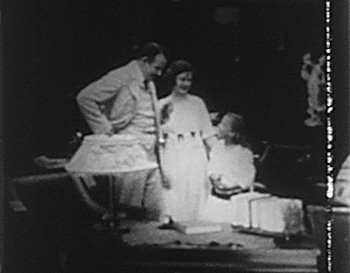The Doll-House Mystery (Reliance, 1915)
 The Doll-House Mystery (Reliance, 1915)
The Doll-House Mystery (Reliance, 1915)
Directed by Chester and Sidney Franklin
Starring Charles Gorman, Jack Hull, and Ben Lewis
John Grant (Charles Gorman), a wealthy man, has just brought home a stack of bonds. He has a young daughter, Carmen (Carmen De Rue), who sees him put the bonds away and is instantly enthralled by their “pretty colors”. That night, she tiptoes downstairs and quietly removes them from the desk drawer. She and her friend, Georgie (Georgie Stone), use them to wallpaper their playhouse.
When John discovers the bonds are missing, he calls a detective (Ben Lewis) to investigate. The detective thinks it must be an inside job and so devises a ruse to trap the culprit: John will return home the next day with a new stack of bonds and will put them in the same desk drawer. The detective will sit out in the hall all night, waiting to catch the thief when he makes his move. All goes according to plan, until the detective gets a little too involved smoking his cigar and doesn’t notice Carmen make off with the bait.
Georgie comes over to play the next morning and Carmen gives him a few of the bonds. As he’s leaving, the detective spots him carrying the bonds and follows him home. He discovers that Georgie’s father is Jim Morley (Jack Hull), a convicted thief recently out of jail. Georgie shows his father the bonds and Jim doesn’t know what to do. He can’t return them – he’d be blamed for their theft and nobody would believe his denials.
After Jim goes to work, the detective approaches the house and gets Georgie to let him in. He tells Georgie that his father sent him for the bonds. Georgie at first believes him and hands them over, but after a while begins to think he’s made a mistake and runs to go tell his father what happened. Jim, realizing the police will be coming for him any second, takes Georgie and flees.
Meanwhile, Carmen shows her mother (Marguerite Marsh) the redecorating she and Georgie have been doing to their playhouse and it’s quickly discovered who actually took the bonds. John goes to the station to call off the search, but learns that a manhunt is out for Jim – who’s presumed armed and dangerous. He’ll have to stop the detective and his posse before a tragedy occurs.
I’ve read someone else’s review of this film and they focused on the cultural difference it captures between the society of 1915 and that of today – namely, that it would be taken for granted in 1915 that the poor man would be presumed guilty if he attempted to return the bonds. I don’t see it; I think he would be presumed guilty today, too. The intent of the film is unclear, in my opinion. Had it not been immediately revealed that Carmen took the bonds, it would have placed the audience in the same position as the detective: left to assume the ex-con’s guilt. When Mother discovers the bonds in the playhouse, it would then have had a much greater impact – revealing to the audience their own prejudice. If the picture was going for an anti-profiling message, it’s a huge missed opportunity. As it is, I’m not sure what the moral is.
That sounds highly critical and you might think I disliked the film, but you’d be wrong. I loved the cinematography. When Georgie first shows Jim the bonds, we see him in tight close-up. With each successive scene, the camera pulls further and further back. In the end, when Jim is on the lam and holed-up in a remote shack, the camera must be a quarter mile away, looking down on this tiny, fragile building lost in an empty expanse of barren ground. It really captures the growing hopelessness of the situation.
I would recommend it for that alone, but story is engaging enough, too – even if the underlying idea is difficult to suss out.
My rating: I like it.
Posted on October 2, 2013, in Like it, Reviews and tagged 1915, Ben Lewis, Charles Gorman, Chester Franklin, Jack Hull, Reliance, Sidney Franklin. Bookmark the permalink. Leave a comment.
Leave a comment
Comments 0